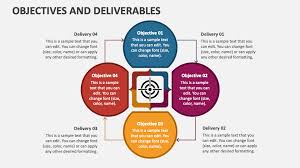If you manage projects, you likely hear the terms “objectives and deliverables” frequently. These aren’t just buzzwords; they are critical components of successful project management.
- Objectives define the big picture—what the team aims to achieve.
- Deliverables are the specific outputs or tasks that help accomplish those objectives.
Together, they shape the project timeline and keep all stakeholders aligned. Without well-defined objectives and deliverables, projects can suffer from resource waste, missed deadlines, and a lack of direction.
What Are Project Objectives?
Project objectives are measurable statements that define what a project aims to achieve within a given timeline. Unlike broad mission statements, objectives are specific and actionable, serving as a guiding framework for stakeholders and team members.
A well-defined objective sets a clear direction for deliverables and helps in tracking project progress.
Example: Launch a functional e-commerce platform within six months to increase online sales by 20%.
Project Objectives vs. Goals

| Project Objectives | Project Goals |
|---|---|
| Specific, measurable outcomes tied to project scope. | Broad, high-level aspirations. |
| Clearly defined with tangible completion criteria. | Less precise, focusing on vision. |
| Managed by project teams and project managers. | Typically set by leadership. |
| Example: “Develop five marketing campaigns in Q1 to increase leads by 15%.” | Example: “Become an industry leader in digital marketing.” |
What Are Project Deliverables?
Deliverables are tangible outputs or results that help fulfill project objectives. These can range from developed software to documentation or training materials. Deliverables may be internal (used within the team) or external (delivered to clients or stakeholders).
Difference Between Objectives and Deliverables

While objectives define what a project aims to achieve, deliverables represent how those objectives are met.
Example:
- Objective: Improve customer onboarding experience.
- Deliverable: A user-friendly onboarding guide and an interactive training module.
Examples of Project Deliverables
- A software onboarding guide for new users.
- An analytics dashboard for monitoring key project metrics.
- A risk assessment report outlining potential project risks and mitigation strategies.
- API documentation for seamless integration with third-party systems.
Project Scope, Objectives, and Deliverables
Project success depends on aligning the following:
- Scope: Defines project boundaries and focus areas.
- Objectives: Specify the desired outcomes.
- Deliverables: Represent tangible results created to achieve objectives.
Example: For a SaaS company aiming to improve user retention, the scope might focus on a feature upgrade rather than a full system overhaul. Deliverables could include a beta-tested feature update and user documentation.
How to Write Clear Objectives and Deliverables
- Define the project scope: Outline focus areas and exclusions to set realistic expectations.
- Set measurable objectives: Use metrics like percentages and deadlines (e.g., “reduce churn by 10%”).
- List deliverables explicitly: Identify all required outputs such as prototypes or reports.
- Collaborate with stakeholders: Gather input to ensure alignment with business goals.
- Consider resources and budget: Keep objectives and deliverables achievable within time and budget constraints.
- Review regularly: Schedule check-ins to confirm objectives remain relevant and deliverables stay on track.
Objectives vs. Outcomes
While often used interchangeably, objectives and outcomes are distinct.
- Objectives outline what a project aims to accomplish.
- Outcomes represent the long-term impact of achieving those objectives.
| Objectives | Deliverables | Outcomes |
| Measurable targets defining project success. | Tangible outputs created to meet objectives. | Long-term improvements resulting from the project. |
| Defined during project planning. | Delivered during project execution. | Realized after project completion. |
Example:
- Objective: Launch a reporting feature by Q2.
- Deliverable: A new analytics dashboard.
- Outcome: Improved user retention and engagement.
Best Practices for Defining Objectives and Deliverables
Writing Effective Project Objectives
- Use action words like “launch,” “increase,” or “reduce.”
- Quantify success with measurable criteria.
- Keep statements concise and aligned with business goals.
- Use SMART objectives (Specific, Measurable, Achievable, Relevant, Time-bound).
Defining Deliverables Effectively
- Identify deliverables early in the project planning phase.
- Clearly describe the purpose and expected outcome of each deliverable.
- Assign ownership to ensure accountability.
- Set deadlines aligned with project milestones.
- Integrate quality checks to maintain standards.
Final Thoughts
Well-defined objectives and deliverables are essential for successful project execution. By aligning them with project scope and stakeholder expectations, teams can drive efficiency, stay on track, and achieve meaningful outcomes. Implementing these best practices ensures a structured and results-driven approach to project management.